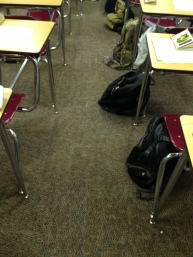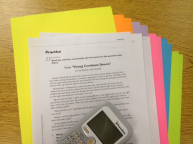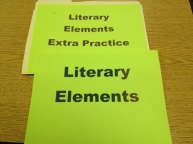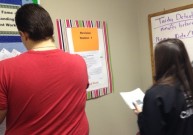As a parent, I have often admired brightly colored and well-organized learning stations when visiting my own kids’ elementary school classrooms. For years, I’ve wished that I could integrate more movement and hands-on learning in my classroom, but there were three main barriers: 1. space 2. attitude and 3. time.
Space
Though I’ve taught in several high school classrooms over the years, most have narrow spaces for walking. With dozens of students and their large, heavy backpacks, coats, and lunch bags to navigate around, I can barely monitor my students’ work, let alone plan for large motor movement!
Teen Attitude
I remember listening to some classroom management tips given by an elementary school teacher to a K-12 group of teachers years ago. While her ideas were clever, the secondary teachers in the room smirked at them. One technique in particular, which involved students holding up an index finger to signal that they were listening, prompted one experienced secondary teacher nearby to mutter, “Yeah, the high school kids would hold up a finger all right, but it wouldn’t be the index!”
Time
As a teacher who sees about 130 students every day in my room, I’ve tended toward looking upon planning for stations as an idealistic and quaint notion. Gazing at a stack of 100+ essays to grade does not inspire creativity.
Learning Styles
While I pondered these barriers, another important reality emerged: when I gave my students a learning style quiz at the beginning of the year, I learned that the vast majority are kinesthetic and musical learners. Those styles are more than just “fun”; they’re how my students learn, and I need to teach their way.
Obviously, the idea of centers has to be modified for the secondary classroom, but it’s not impossible. I’ve been integrating more movement and music over the years. Here is one activity I came up with to address all of the above issues. Here’s how to give it a try:
Supplies Needed
12 sheets of colored of paper (2 per color)
Subject area workbooks/worksheets (I used test prep work since that’s what we’re about to do around here)
Access to a printer & copier (black ink only is fine)
Class set of student response devices or clickers— optional
Computer with speakers and playlist – optional
Prep
This part is the most time-consuming, but it’s no worse than for any other lesson I’ve made myself. First, simply choose six different areas in which you’d like your students to practice. Mine were vocabulary, literary elements, reading comprehension, and revision. I divided the latter two into two centers each. Assign them each a color and print signs with the category label on them (see photo below).
Choose a couple of multiple choice test prep worksheets per category. One will be the actual center and one will be extra practice. Re-size the one you chose for the center on the copier so it’s easily read when posted on the wall. Make copies of the extra practice (I’ve no advice on this one – I made 30 of some, which wasn’t enough – 75 was too many).
Post the six colored signs around your room (with enough space for students to congregate). These are the beginnings of your centers. Then affix the second sign for each color/label on a folder. Put your extra practice copies for that category in there.
Be sure to have keys for both the center and extra practice worksheets for each station. If using clickers, input your center keys and randomize the order the clicker gives the questions to the students. This keeps the students from clumping up at one station.
Make some student instructions on your interactive whiteboard, chalkboard, or whatever means you typically use. Whether using clickers or not, students should write the station names/abbreviations on notebook paper. They can track their progress around the room this way. Make sure they record whether they got the item right or wrong because they’ll use that information to self-remediate in the next step.
Tell students that when you start the music (I made a peppy YouTube playlist with songs about circles but didn’t show the videos – we just listened as we worked), they will have 10 minutes (or whatever amount of time is appropriate for your activities) to go through the stations. They should mark whether they got the question right or wrong on their papers. Mine used the clickers to grade their work, but if you don’t have clickers, you could simply grade them together after everyone sits down.
When students finish all the stations, they’ll grab extra practice from the folder at the station where they missed questions and complete it. Those who didn’t miss any should have other work to do (mine had novel analysis to fill out). Place the answer keys at the stations so they can self-grade their work (I put them out AFTER they’re all seated, then take them up at the end of class).
After giving students time to complete the extra practice and grade it, you can do another rotation. We did the first question at each station the first time, and the second one the second time. Have them turn in the notebook paper they used or use the clicker data to get feedback from the activity.
Student Reactions
The best comment I heard was, “We should do this every day!” When asked why, the student answered, “Because it’s a lot of fun, we get to move around, and we burn calories!” I took the smiles and groovy dance moves of other students as they moved between stations as positive feedback too. Best of all, there wasn’t a bad attitude in sight. Since it’s standardized testing time around here, that’s saying something!
If you have questions or want to share how this idea might work in your classroom, please comment!





I would love to see how I can apply this to my 9th grade English class!
Great, Quishandrea! Let me know how it goes or what I can do to help.
Excellent blog article! I found ypu through pinterest. Thanks so much for sharing what you’ve done. In grade 8, I’m not doing the “finger in the air” strategy either. LOL
But I do try to include music, movement and visual along with language while engaging my students in their content and I’m always eager to hear what has worked for others, especially since some groups of kids respond differently so it’s a process.
Thanks, Tammy. The learning styles inventory at the beginning of the school year was really an eye-opener for me.That really helped me figure out what types of activities to incorporate for the school year. The kinesthetic learners (read: lots of athletes) loved anything where they could get out of their seats, but the groups that were primarily intrapersonal learners weren’t fans of it. If you want to try a new activity and ensure it isn’t a big bust, I recommend giving them a learning styles inventory and figure out what the top 2-3 learning styles are for each class period.
Marisa
Hello,
I’m a high school English teacher, and centers are now mandatory in our classrooms. I’m all about doing what’s best for the kids, so when I saw this post, I knew this would be helpful to meet company requirements. My question comes down to your clickers. I don’t have a physical set, we use Plickers, but that requires me leading the lesson and having the kids hold up their paper QR codes and scanning them with my iPhone.
What brand do you use? I have a set of ipads I can check out, and there are apps that might fit the bill, but if you could explain how the clickers you have allow centers to happen, I’d be able to conceptualize it better.
Thank you in advance for your feedback 🙂
Hi Tara,
The key for this particular set of clickers is that they could be assigned to each student, by either name or number AND that they work well for writing-based answers because they have a full QWERTY keyboard (but so does the average student response app). That means there was no “anonymous” answering potential for this activity (because that’s when off-task silliness begins). They are Promethean Active Expression 2 student response devices that work through the Active Inspire software that comes with a Promethean board. Each “click” is collected in a spreadsheet, which can be imported into a grade book via a csv export/import process.
So, visualize each student in the class carrying around his or her own (AA battery powered) individual clicker (that they’ve been using regularly all school year) to the stations. These particular clickers communicate with your computer/software by being on the same WiFi network. I set the clickers to tell the students immediately whether they chose the correct answer or not (per question). We tested the range of these clickers and found that students could go outside my classroom, shut the door, and head all the way down the hall with them (fantastic for a scavenger hunt activity). This also meant that if a student had missed a test and needed to make it up, I could send them to the next room or to the hallway where they could enter their answers while the rest of the class went over the graded test.
As far as clicker management goes, I had one class set, so students were required to leave them on their desks at the top right corner before they left for the day. That minimized any clickers “walking off” in someone’s backpack. One or two temporarily went missing, but I always knew whose it was because the clickers corresponded to my seating charts for each class period, so it wasn’t hard to track them down. I used my label-maker to them with numbers so I could easily refer to them. The batteries generally needed changed once or twice a school year, so make sure those are part of the school’s or department’s budget if you get clickers.
The nice thing about clickers is that, unlike using BYOD, where students bring their own mobile devices and use a student response app on them, there is no potential for the students to get distracted by other apps, take photos/videos of test/assignment materials, or otherwise cause you a lot of new classroom management issues to deal with. Plus, students who can’t get on school wifi may have BYOD issues with going over their data limit that can stop your activity in its tracks.
If you are using school-owned mobile devices like iPads, that all depends on how well they are “locked down” from such distractions (but that could backfire if you can’t easily install the app you need).
I hope this answers you question, but if not, let me know!
Marisa
I’m a new teacher and would love to implement something like this.
How did it work long term? Did you see that the students were honest in their responses? I teach 5th and 6th grade Language Arts and Writing.
Hi Kay,
The students were honest in their responses. They were prepping for EOI tests, of which they are required to pass a certain number of in order to graduate high school. The standard EOI prep for all core subjects is working through a boring state test prep booklet of sample questions. These too were sample questions, but the difference for the students is that they got timely and immediate feedback per question/station (as opposed to waiting a day or more to find out if they were on the right track with their answers or not) and they got to get up, move around, and listen to music (instead of being hunched over in desks working in silence as they were expected to do most of the rest of every school day).
In my experience, building consistent classroom management practices, respect, and relationships with students is the best motivation for students to give sincere effort. By this point in the semester (spring), my students and I had those items well-established, so they would complete an activity like this whether it was graded or not because they trusted that I would never give them “busy work”.
Have fun!
Marisa